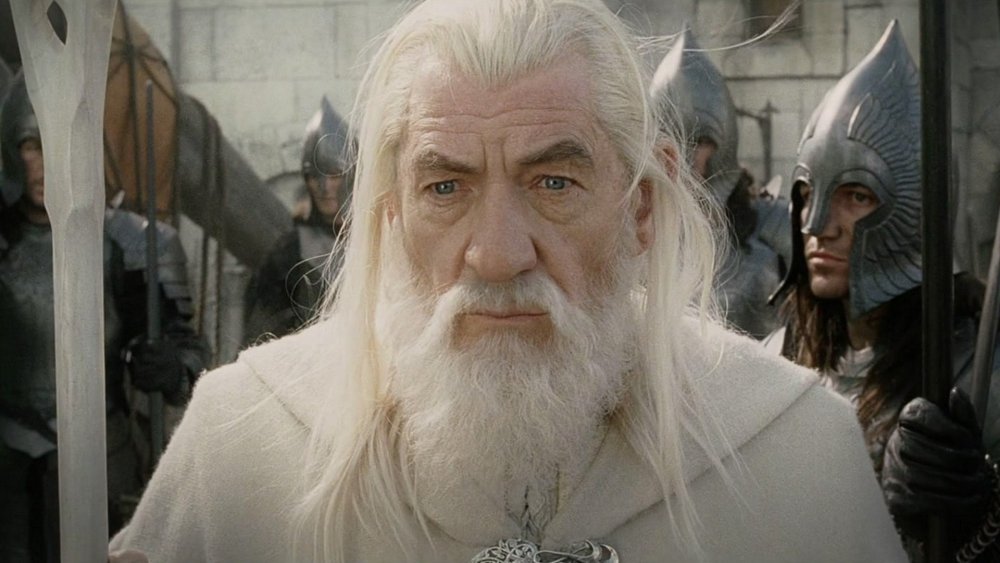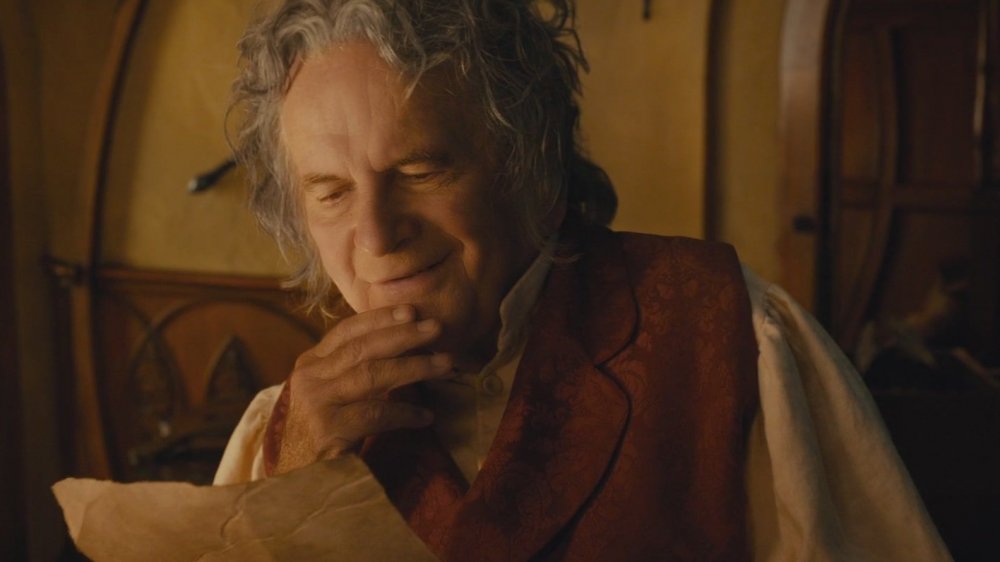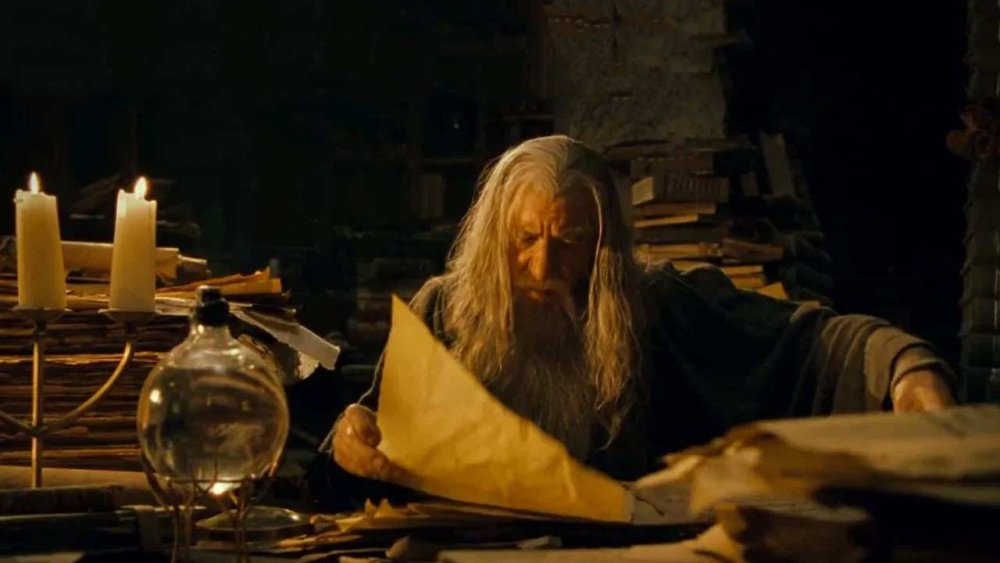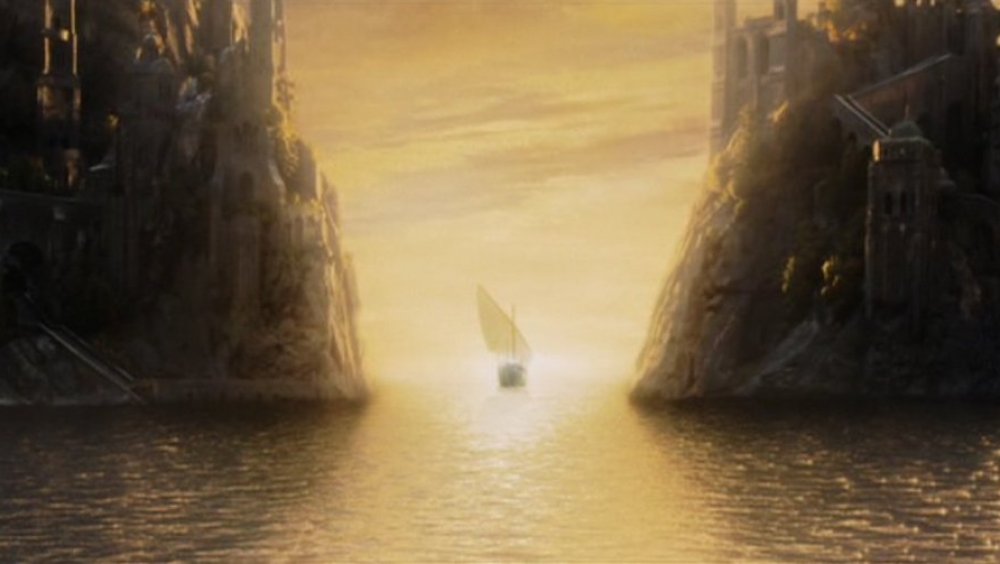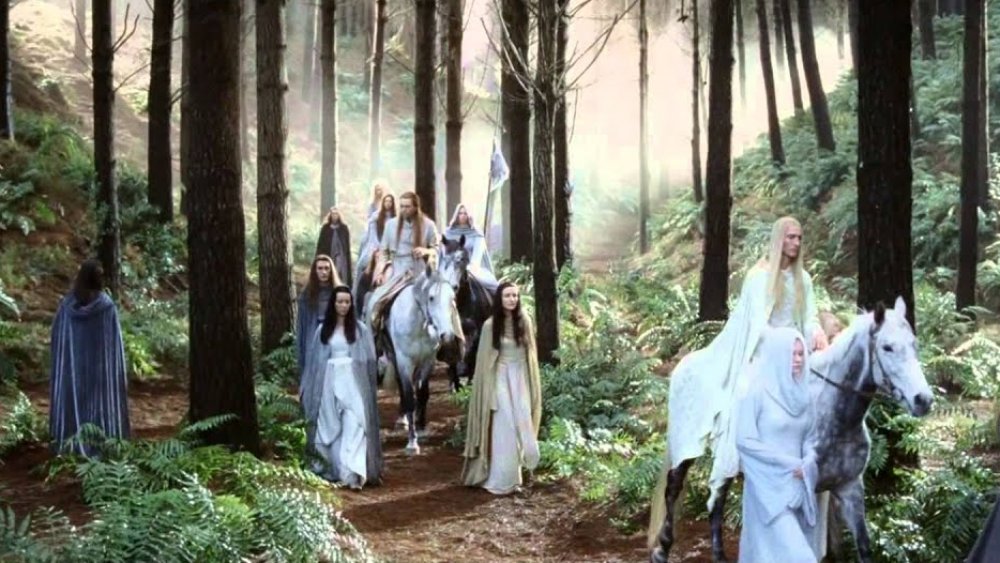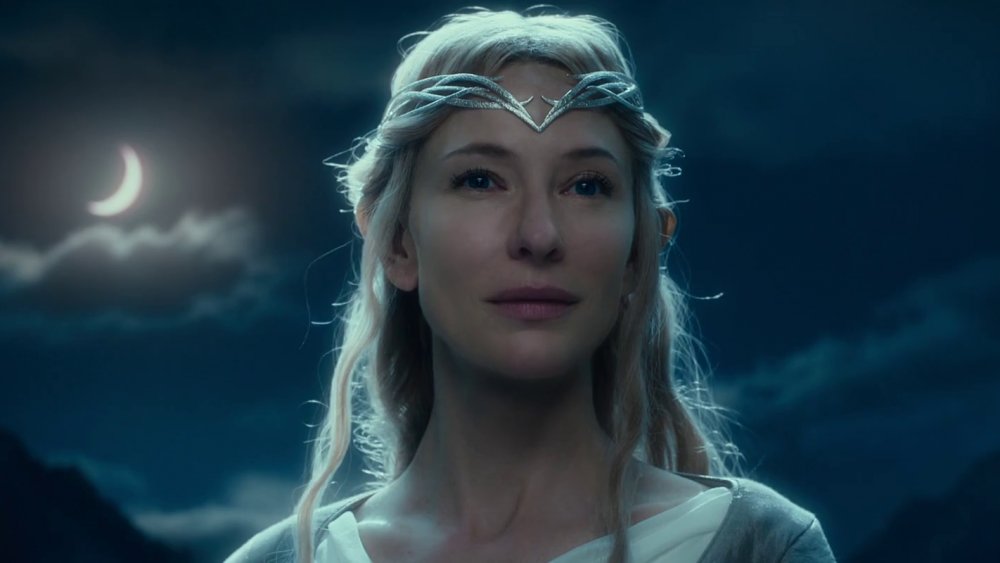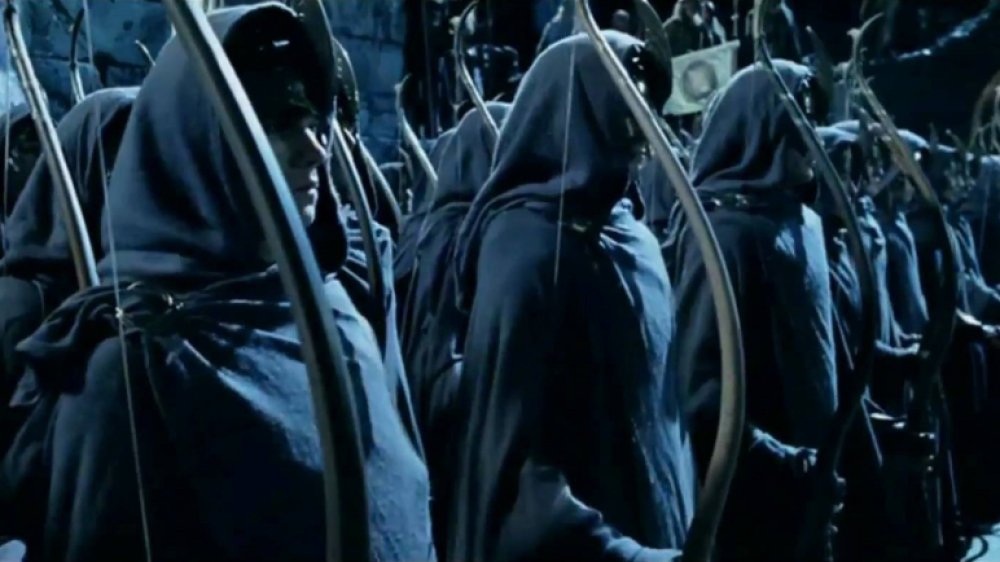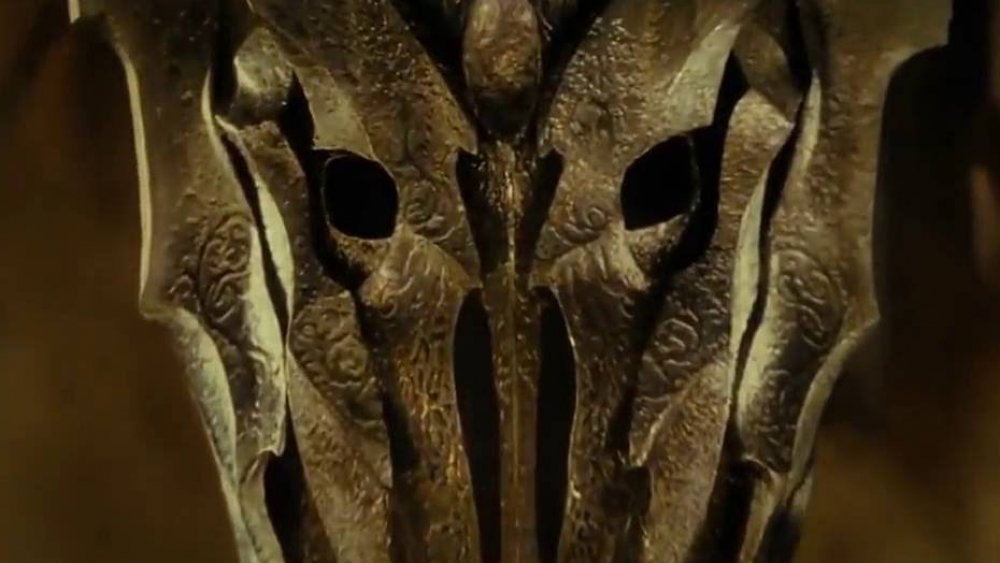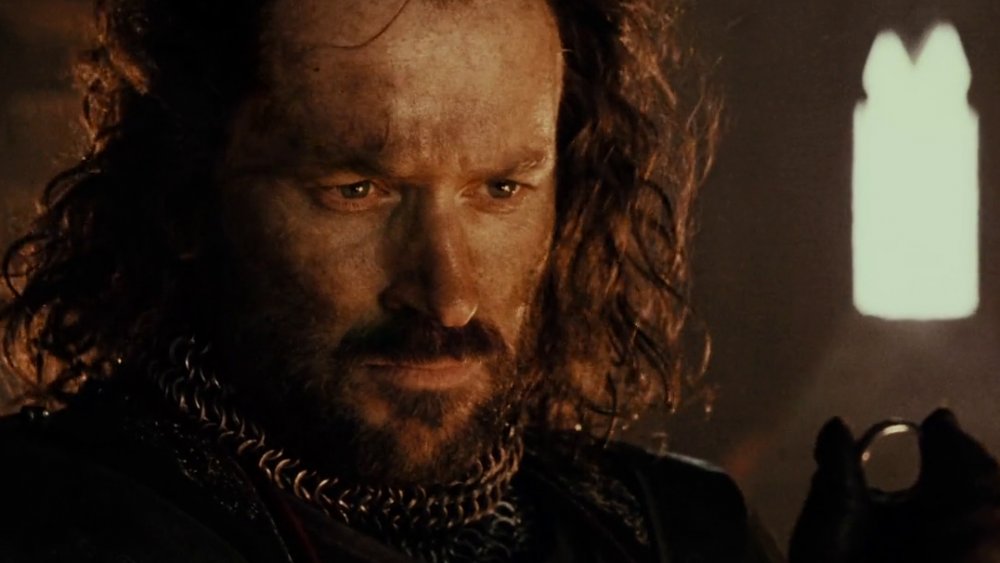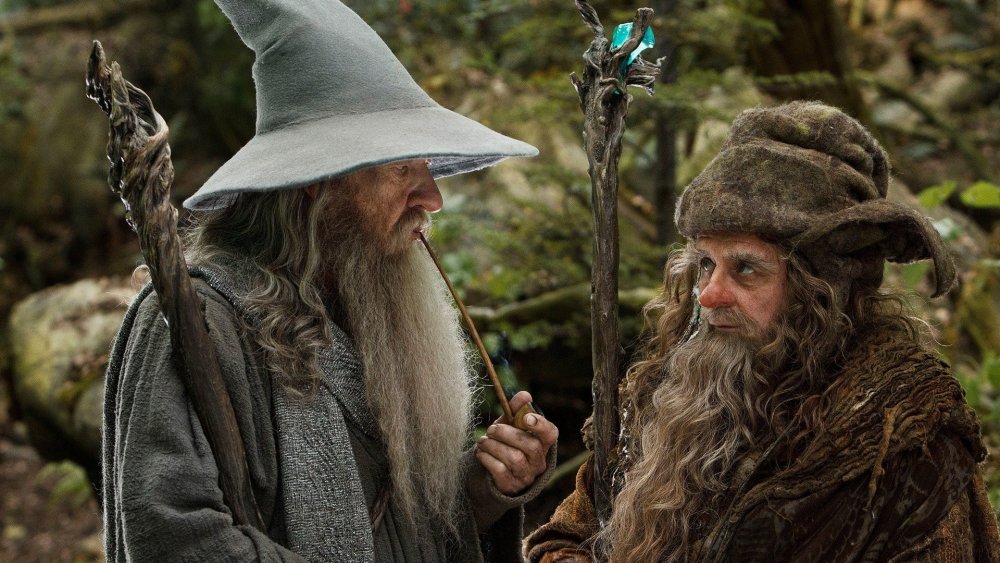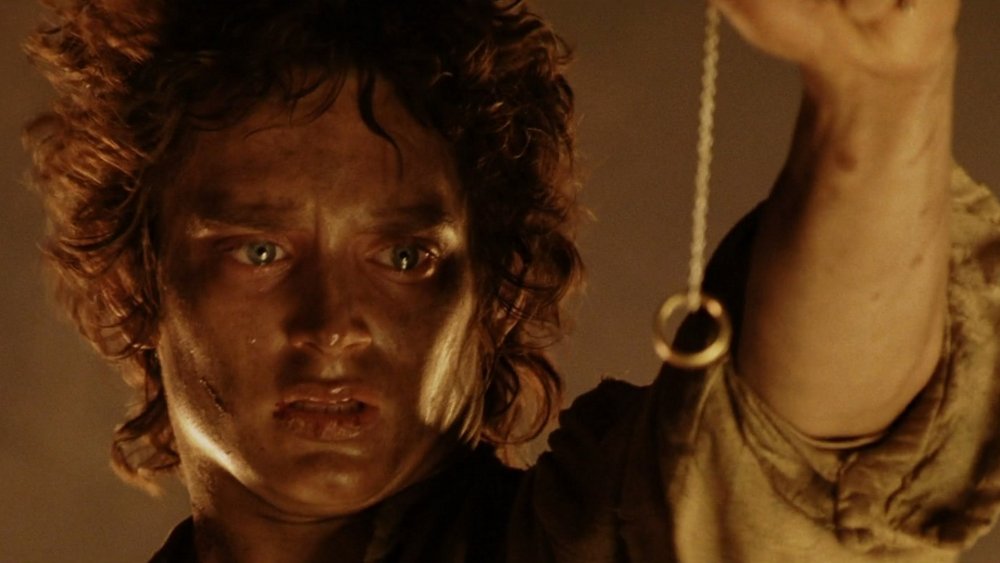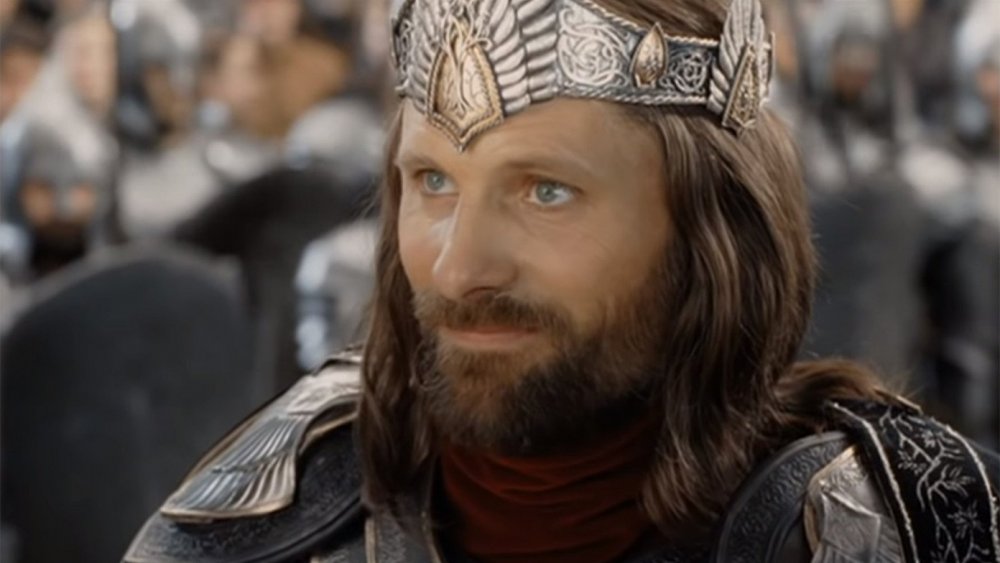The History Of Middle-Earth Explained
Anyone who's either read or watched The Lord of the Rings and The Hobbit is aware of the incredible complexity of J.R.R. Tolkien's fantasy world. Whether you're talking about an Earth-shattering war between orcs and men or a Hobbit drinking tea in the parlor, everything has a lengthy pedigree behind it. But while this brings a huge dimension of depth to the story, it can also be a bit confusing at times. Adding even more fuel to the mythological fire, Amazon's Tolkien-esque mega-series takes place in the Second Age of Middle-earth history. This puts it thousands of years before the events that movie lovers are familiar with.
All of the storied complications and time-hopping can cause quite a few headaches for fair-weather fans who are just along for the cinematic ride. But even for those who've taken the rather overwhelming deep dive into The Silmarillion, it's still easy to get lost in all of the names, dates, and events — which is precisely where a nifty timeline-driven narrative can come in handy. So let's back up to the beginning and take a quick trip through Middle-earth history, starting before time itself and ending in the triumphant days after the One Ring was destroyed.
In the beginning, before Middle-earth
Tolkien's world begins with the events of the Ainulindalë or the Music of the Ainur. The Ainur are a race of angelic spirits that are the offspring of the thought of Ilúvatar, the creator and chief being in Tolkien's world. The Ainur are known for their singing, although initially they only sing individually.
Eventually, Ilúvatar informs the Ainur that he wants them to compose a "Great Music" with Himself. The song consists of three themes, but while the host sings together, one of the Ainur named Melkor repeatedly attempts to take over the music and lead it himself. While he succeeds in causing chaos at first, his creator ultimately weaves that chaos into His greater song, defeating the Ainur's ambitions.
When the song ends, Ilúvatar reveals a vision to the Ainur, showing them that the song was the universe and its history, which he then brings into being. Many of them enter into the new creation and begin shaping it into the vision Ilúvatar showed them. They focus, in particular, on a specific part of the world known as Arda, effectively becoming angelic shapers and stewards of the Earth.
Thirteen of these spirits become known as the Valar, the great Powers of Arda. The rest remain lesser yet still very powerful beings called the Maiar. Once the Valar and Maiar arrive in Arda, they begin to shape it. They build mountains, fill lakes, invent flora, and so on. However, Melkor also arrives in Arda and proceeds to play the part of universal jerk and bully.
Wars among the gods and the Years of the Lamps
When he arrives in Arda, Melkor claims lordship of the entire region and begins to spitefully undo all of the Valar's work. This ultimately leads to the first great war between the powers, during which many of the Maiar join both sides of the conflict. The war only ends after a hulking Ainur named Tulkas arrives on the scene and helps to overthrow Melkor. Tulkas becomes the fourteenth Valar, Melkor gets the heck out of Dodge, and peace is restored.
After this, the Valar settle down in the middle of Arda — known as Middle-earth — and they continue to build the world. In order to provide light for their work, one of the Valar named Aulë sets up two huge pillars in the northern and southern regions of the continent. They're taller than mountains, and each one is equipped with a massive lamp to help illuminate the world.
Countless years of god-like worldbuilding go by until, one day, Melkor returns and secretly attacks Middle-earth. We're not even talking about a full-on war this time, either. This go-round, he executes his nefarious schemes by simply sneaking into Arda and breaking the two pillars of the lamps, which consequentially shatters the surface of the Earth, breaking it apart into multiple continents. The event causes such chaos and destruction that one of the Valar, named Yavanna, puts a sleep on the entire creation before she and her colleagues hightail it out of the catastrophe and abandon Middle-earth, fleeing to the continent of Aman far in the west of Arda.
The Blessed Realm and the Years of the Trees
After the destruction of the lamps, the Valar set up shop in the far west of Arda on the continent called Aman (aka the Blessed Realm). This land, and their home of Valinor within it, would become the Valar's permanent dwelling for the remainder of the history. In fact, when Frodo and Bilbo sail into the west at the end of The Return of the King, they are, indeed, heading for Valinor. Although at that point, it's geographically a little bit harder to reach — more on that in a bit.
Once the Valar and their people arrive in Aman, they create giant mountain ranges to protect themselves from Melkor, because who needs a white picket fence when you can just raise a mountain like it's a sandcastle? Yavanna then shows up again, this time helping to create a light source for their new western realm. She does this by bringing two massive, gloriously glowing trees into being, each of which takes turns illuminating the continent.
The period that follows is very long and undefined. During this time, the Valar work on their new home, and Melkor continues to plot and scheme out in Middle-earth. Also, another of the Valar, named Varda, hangs stars in the sky in order to light the path for some long-awaited guests.
The history of the elves and the dwarves
Back during the creation of the world, Ilúvatar explained to the Ainur that his "children" would arrive on the scene at an undisclosed time. These children — that is, elves and men — would be autonomous and independent of the greater spirits, and they'd play a primary part in the story of the world. But over time, Aulë gets impatient and decides to create his own children. While he ultimately repents of his hastiness, Ilúvatar decides to adopt his new creations, thus bringing the race of dwarves into existence, although he puts them to sleep until his own children awaken.
At some point after this event, the Valar learn that the elves have finally appeared on the scene. They decide that they need to put Melkor in his place before these children of Ilúvatar are caught up in another cataclysmic event like the one that ended the Years of the Lamps. Catastrophes aside, it's also at this point that many elves are likely captured by Melkor and warped into the race of the orcs.
With so much at stake, the Valar go to war yet again, this time conquering Melkor and bringing him back as a prisoner. They then invite the elves to come and live with them in the Blessed Realm, and many of them accept the invitation. Those that remain behind set up homes and kingdoms under the stars in Middle-earth. Three ages follow during which Melkor is held captive, and the elves and Valar live in blissful peace in and around Valinor.
The Silmarils and the dimming of Valinor
During the long ages known as the Years of the Trees, an elf named Fëanor creates three gems called the Silmarils. These contain some of the light of the two trees of Valinor, and they're considered the greatest jewels in the world. Around this time, Melkor is released on parole, and it takes him all of two seconds before he begins to secretly whisper lies and cause dissension among the elves in Valinor. Eventually, he recruits a monstrous spider-spirit named Ungoliant, who sucks the life out of the two trees. The pair of villains then steal the Silmarils and head back to Middle-earth.
That's when Fëanor rebels against the Valar's commands and leads his people — a portion of the elves known as the Noldor — out of Valinor in pursuit of Melkor (whom the elves call Morgoth from this point forward, so we'll do that as well). This rebellion is incredibly destructive, as Fëanor's people kill elves that get in their way, steal a fleet of ships, and are cursed and banished by the Valar for their destructive behavior.
Ignoring the consequences of his actions, Fëanor recklessly leads his people back to Middle-earth, where he scores some easy victories against Morgoth's hastily gathered armies. However, Fëanor dies early on in the fighting, and his people are unable to completely conquer their enemy. Instead, they begin to settle down for a long struggle that ultimately lasts for several centuries.
The First Age of Middle-earth
Around the time that the rebellious Noldorin Elves arrive back in starlit Middle-earth, the recently burned Valar — ever playing the part of guardians and stewards — show some pity for them by launching the sun and moon into the sky to illuminate their path.
While the specific parameters of a "First Age" in Tolkien's writings are difficult to pin down, it's likely around this time in the narrative that the First Age begins, although it's sometimes described as overlapping with the Years of the Trees. This point in the story also roughly coincides with the awakening of the second set of Ilúvatar's children: men.
The age ends nearly six centuries later. This epic period of time involves a protracted series of wars that are far too complicated to layout in detail. Suffice it to say that initially, the elves gain the upper hand and set up a centuries-long siege of Morgoth's main fortress of Angband. However, after several hundred years, Morgoth's armies suddenly break out of the siege and win several victories that leave the elves reeling.
At this point, the Valar return to Middle-earth, coming to the aid of the Elves in the War of Wrath. This catastrophic conflict ends with Morgoth's complete defeat and banishment into the Timeless Void, although it comes at the cost of yet again damaging the world and flooding the eastern portion of the continent.
The Second Age of Middle-earth
After the cataclysmic events that end the First Age, the Valar and many of the elves head back to Valinor, while other elves — along with men, dwarves, and a variety of evil creatures — make their way east further into Middle-earth. It's at this point that the map begins to look much closer to the one from the Lord of the Rings. The primary exception is that the Valar create an island between Valinor and Middle-earth for the favored Númenorian race of men to dwell on. On the mainland, several elven kingdoms are eventually established, including Rivendell by Elrond Half-elven.
While Morgoth is banished at this point, many of his servants are still at large, and they continue to cause trouble as the Second Age unfolds. Most of the trouble ultimately comes from his lieutenant, a character that most Tolkien fans will recognize: the Dark Lord, Sauron. Early in the age, Sauron established himself at Mordor and then tries to seduce the elves into trusting him. He helps them forge rings of power and ultimately attempts to control them by creating the One Ring to rule them all.
While his plan backfires and the elves hide their rings, Sauron ends up getting his way anyway — in the short term, at least — by using brute force. He conquers most of Middle-earth and is poised to finally control the entire continent when he runs into a roadblock.
The downfall of Númenor and the end of the Second Age
Sauron's conquest of Middle-earth only stops when the Númenóreans arrive on the mainland with a massive army. The Dark Lord surrenders himself without a fight, and he's taken back to Númenor. There, he convinces the Númenórean king to turn on the Valar and attack the Blessed Realm in a ridiculous attempt to gain immortality — something that's obviously way over the line.
At this point, the Valar, probably rolling their eyes at this ludicrous behavior, come to the end of their rope and turn the matter over to the creator. Ilúvatar then steps in and literally sinks the rebellious island of Númenor in an Atlantis-like catastrophe. At this point, the shape of the Earth literally changes from flat to round, and the Blessed Realm becomes exclusively accessible by a magical path that only the elves can find.
In the meantime, a small group of survivors known as "the Faithful" escape back to the mainland of Middle-earth. Once they're there, the faithful Númenóreans set up the kingdoms of Arnor and Gondor. It doesn't take long, though, before Sauron reappears on the scene and begins causing trouble yet again. However, as the Second Age wraps up, the Númenórean kingdoms ally with the elves of Middle-earth and form the "Last Alliance of Elves and Men." Fans of Peter Jackson's trilogy should recognize this, as it's basically the opening scene from The Fellowship of the Ring when the One Ring is cut from Sauron's hand. With Sauron defeated, peace comes to Middle-earth for a time.
The Third Age of Middle-earth
This first major defeat of Sauron marks the end of the Second Age. The 3000-year-long Third Age that follows is mainly defined by the two Númenórean kingdoms of Arnor and Gondor. While they remain strong for a time, eventually Arnor is defeated by the Witch-king of Angmar (yes, the same Witch-king that Eowyn kills centuries later). Gondor endures, but it slowly weakens through invasions, civil wars, and plagues.
Around 1000 years into the age, the five wizards also arrive on the scene and begin wandering about, helping the Free Peoples. They are specifically sent to counter Sauron, who's been slowly recuperating his power over the centuries.
Also during the second half of the age, the Shire is colonized by hobbits, and Gollum murderously claims the One Ring before he heads off to the roots of the Misty Mountains. The elves and dwarves that remain in Middle-earth are fairly quiet during this time, which is chiefly marked by the slow weakening of their political power. However, the dwarves do awaken the Balrog in Moria partway through the age, and they also win a knock-down, drag-out war with the goblins of the Misty Mountains. Again, fans will recognize this via flashbacks from The Hobbit trilogy.
The War of the Ring
As the Third Age winds down, it finally leads us to the events of The Hobbit and The Lord of the Rings. Both tales happen within a century of one another, and the main story picks up again when Bilbo finds the One Ring while on his adventures during the events of The Hobbit. Sauron is also driven out of Mirkwood (where he'd taken up a temporary residence) at this time and heads back to Mordor. This is followed by the Battle of Five Armies, where the evil forces in the northern regions of Middle-earth are crushed.
Next up, we have the events of The Lord of the Rings, during which the wizard Gandalf shepherds the Free Peoples of Middle-earth through the War of the Ring. The forces of the West, chiefly populated by men from the kingdoms of Gondor and Rohan, resist the Dark Lord — and the corrupted wizard Saruman, to boot — long enough for Frodo the hobbit, along with his servant Samwise, to reach the Cracks of Doom and destroy the One Ring. At this point, Aragorn son of Arathorn takes his place as the rightful and returned king of the united kingdoms of Gondor and Arnor.
The Fourth Age begins
Once the dramatic events of the War of the Ring officially wrap up, the Third Age is nearly over. In fact, less than three years after the ring is destroyed, Frodo, Bilbo, and the bearers of the three elven rings (Gandalf, Galadriel, and Elrond) set sail for the Blessed Realm. This is when the Fourth Age begins.
While little is known about this last age of Tolkien's writings, it's reported that Aragorn continues to rule for over a century. Once he dies, his wife Arwen also passes away in grief. Samwise serves seven terms as the mayor of Michel Delving, the largest town in the Shire, and Merry and Pippin both become the heads of their extended hobbit families. It's also rumored that eventually Legolas also sets sail for the west. His traveling companion? Gimli, the only dwarf to ever retire to the Blessed Lands.
And there you have it, an extremely condensed history of Middle-earth from its earliest beginnings to the dawn of the Fourth Age. Countless events and details have been necessarily left out for brevity's sake. However, the general shift in the narrative from creation to the rise of man should be fairly clear ... at least as clear as possible, considering the voluminous notes and versions of source material that J.R.R. Tolkien left for his fans to sift through.
